The first challenge for our first 2nd Monday meeting of 2024 was…where to hold it! Our venue for the last year or so, The George in Brailes, is no longer available and we were unable to book the Brailes Village Hall. After a number of phone calls around and about Ray Pearce, our Chair, managed to book Tysoe Village Hall. As a venue it was OK apart from the idea of having to put £1 coins into a meter for the heating. Around 20 members attended the meeting and, as always, we were pleased to see some of our longest-standing members join us. Our thanks go to Ray Pearce and Julia and Paul Neal for providing tea, coffee and biscuits for the evening, and to Paul Baines for his presentation.
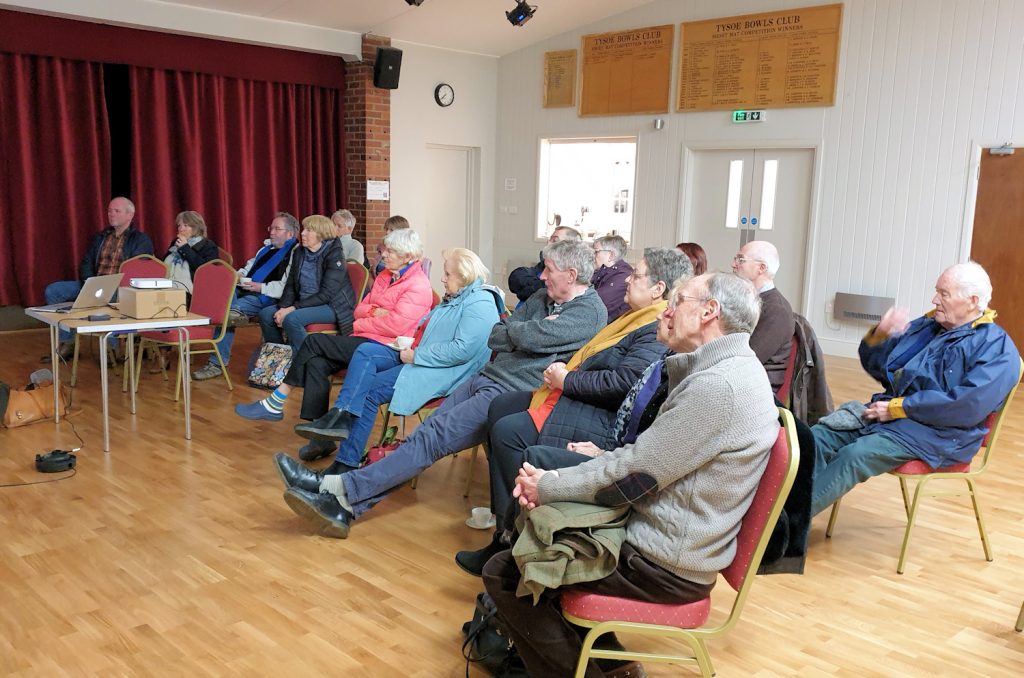
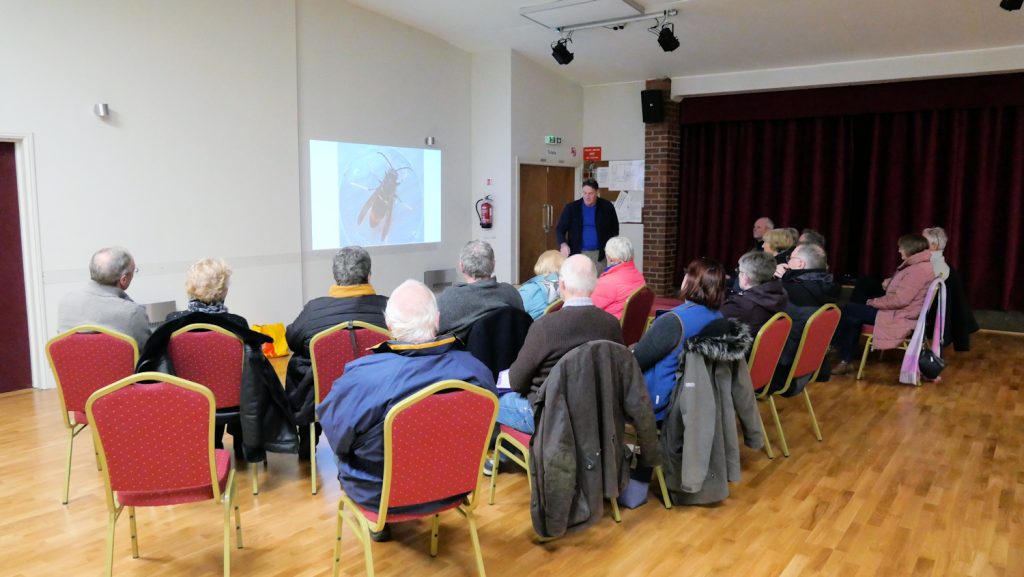
The topic for discussion was Asian Hornet. As we said in the emails announcing the evening, we are trying to get the right line between turning everyone off the subject by endlessly going on about it vs. panicking everyone into buying loads of anti-Hornet gear (already for sale from Thorne’s!).
Normally in a blog report we just outline the discussion as, well, we want members to come to our meetings and not just read about them! But this is such an important topic that in this blog we do go into a lot of the detail that was discussed. Which is a roundabout way of say this is quite a long blog, but please stay with it to the end if you can.
In summary, we believe that it is a matter of when, and not if, the Asian Hornet (AH) arrives in our area, and hence that we need to be prepared.
The enemy arrives…..
The meeting started with a talk by Paul Baines who began by taking us through the arrival of the AH that started with, and spread from, one queen that arrived in Villeneuve sur Lot in 2004, and how they spread at a rate of 60-100km/year. The animation below shows this spread year by year
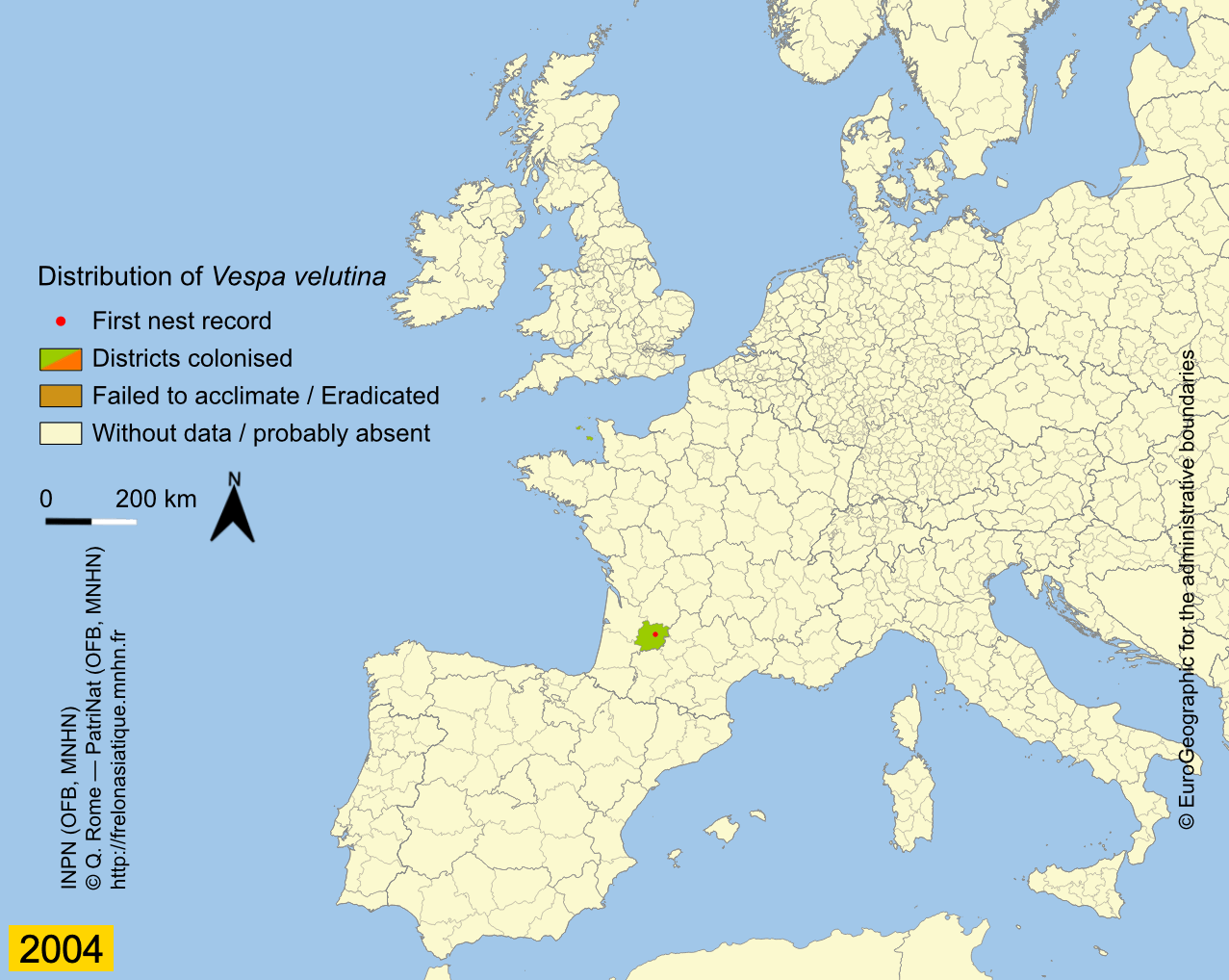
Bringing us up to date Paul showed the data on AH nests found in the UK in 2023
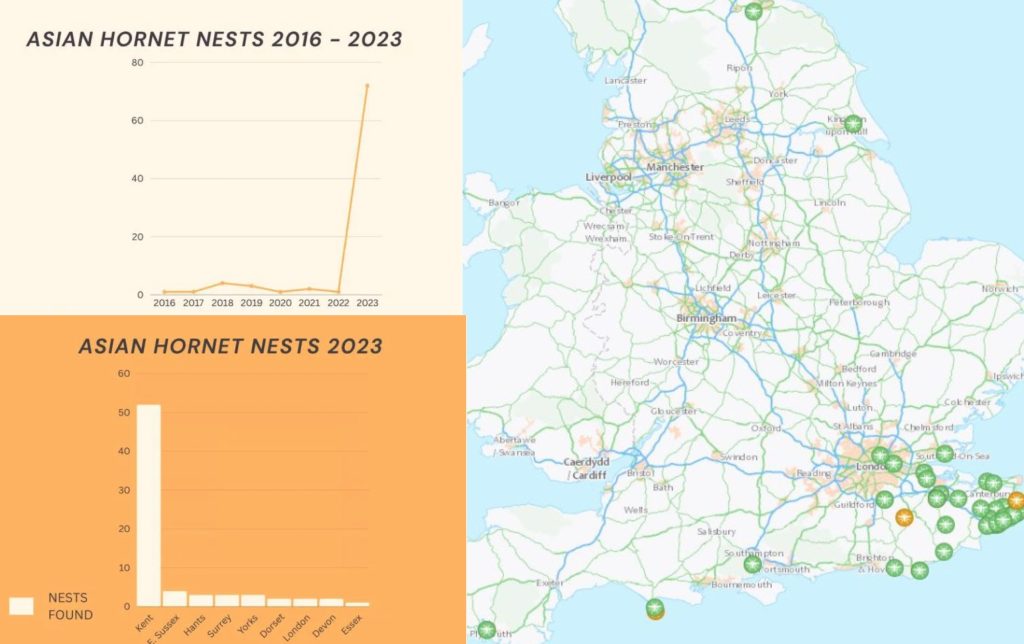
Life cycle of the Asian Hornet
Next, Paul took us through the Lifecycle of the Asian Hornet. It is not dissimilar to that of a wasp in that fertilised queens overwinter as individuals and have a high attrition rate. As the weather warms in March (though timings will vary), the queens emerge from hibernation to feed and then construct a primary nest where they lay and incubate eggs. At this time, the queens remain vulnerable as they must leave the nest to forage. Fifty or so days after the eggs have been laid, workers take over the foraging duties and the queens are then less vulnerable. The nest will be gradually built up. The primary nest will often be in buildings or associated with human habitation and will resemble a small paper wasp’s nest. Primary nests are usually in the vicinity of last years secondary nest where the queen originated.
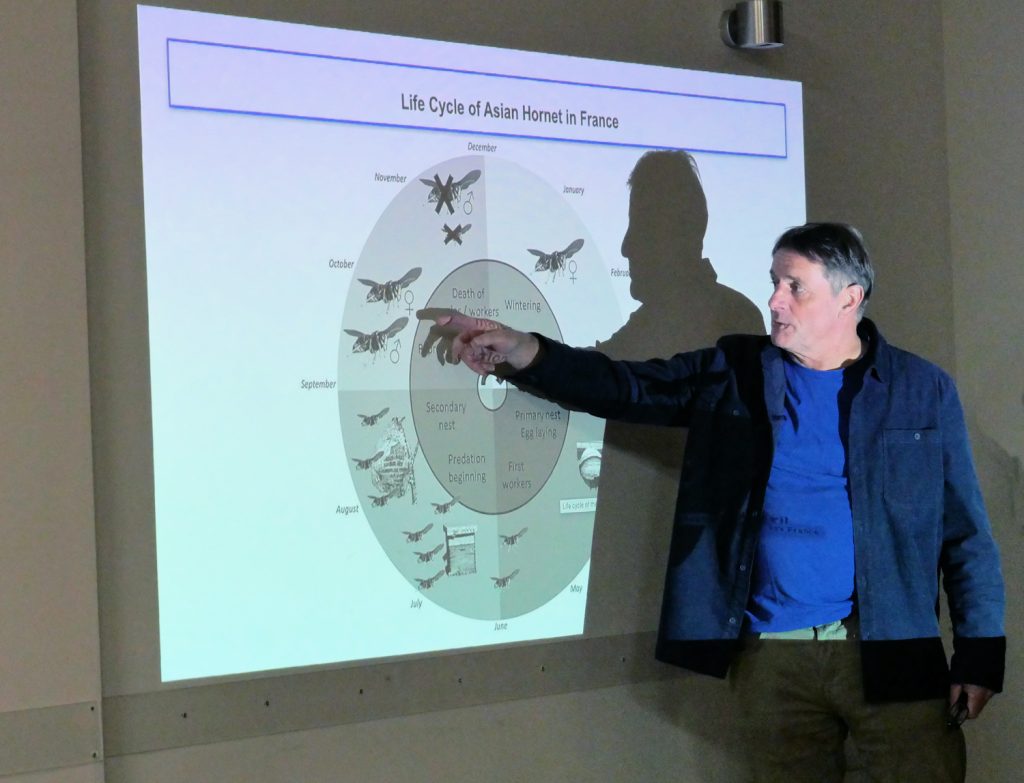
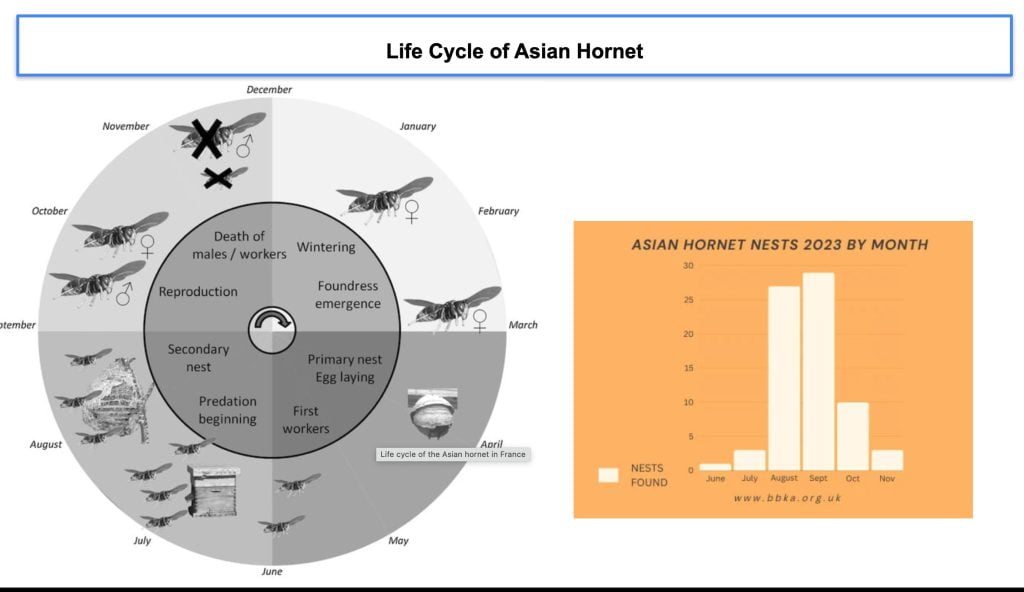
As the nests grows at some stage the hornets may construct a larger and usually higher-placed secondary nest in trees. The number of workers continues to grow. In October and November the hornets produce reproductives, males and females, the females mating with several males and then leaving the hive to hibernate over the winter as the colony dies. Asian hornet colonies may produce hundreds of queens. The nests may be better seen after leaf drop, though this may be too late as the nests may have been vacated by this time.
Predation on bee hives starts in July, but gradually increases as the number of workers grows and continues on as late as November. Initially Asian Hornets ‘hawk’ bees as they return to the hive. This ‘stresses’ the bees and colonies will not forage (even if only a few hornets are hawking outside the hive). Queens may go off lay and generally the bee colony does not flourish. Although Asian hornets may mount a direct attack on the colony (as wasps may) it is the insidious effects of stress and the consequences of the lack of foraging and the failure to produce thriving winter bees that contributes much damage to bee colonies.
What should, and can, we be doing?
At this point Paul showed a (modified) list of actions from an article by Sarah Bunker in BBKA News Dec 2023. A key message here is that Asian hornets are a threat to bee keepers but not just beekeepers. In studies of Asian Hornets diets, in rural areas only 30% of the hornets gut contents are honey bees, the rest are other insects and pollinators. This will affect wildlife in the UK in many different ways and hence we should engage with all those who are potentially affected by Asian Hornets and not just beekeepers – gardeners, agricultural workers, schools, outdoor sportspeople, amongst many others.
The talk generated much discussion so we decided to split ourselves into 2 groups to look at (1) Communication and (2) Monitoring.
Communication
The key message is that we must communicate with various groups that they need to be aware of, and be on the lookout for, AH as they will be affected as much as beekeepers. Target groups include:
- Schools, especially those with a Forest school
- D of E students
- Allotments
- Garden Centres
And the key messages to get across are:
- What to look out for, and
- How to use the Asian Hornet app.
Monitoring (traps)
Based on the life cycle of the AH queens we determined that, starting this year (NOW!), from the end of February through to the end of April, we should all be putting out Kill traps to trap and kill AH queens.
However either these traps have to be inspected daily to release, or they must have an escape route for, ‘by-catch’ i.e. all the other insects that might be attracted to the trap that are otherwise in their own right important pollinators. Suitable attractants for AH queens are sweet carbohydrates, such as apple juice with added sugar. We have information on traps on our AH page on the website here. We will be updating this page in the near future as it was originally created a few years ago.
Traps should not be placed in the apiary but rather some distance – up to 600m – away as the purpose of these is to alert us to the presence of AH queens as and when they arrive in our area. We are looking into how we can record where members place their AH spring kill traps so that we can make sure we have as good a coverage of our area as possible.
What’s next?
We have set aside a budget this year for Asian Hornet education. For example we will make sure that information about AH is available on the Shipston stand at the various village shows we attend in the summer. We are also arranging for information materials to be made available to members, such as AH identification cards.
We will be working on a Communication plan, i.e. how exactly do we target and get information to the key groups identified above.
And all members should have the AH app on their phone. And we also suggest all member attempt the Asian Hornet quiz on the BBKA website; we don’t expect every member to join the Shipston AHAT but the quiz is a good test of Asian Hornet knowledge (you’ll see that you can do the test but decline to have your local Branch informed that you have done so).
https://docs.google.com/forms/d/e/1FAIpQLSff5IvkbPdxHieeNFvbth5VDpGi_XOhGIJ0FXJo-81S455qZw/viewform
However we do have very few members that have passed the test and volunteered to be a member of the Shipston Asian Hornet Action Team; the map below is centred on my home location in Banbury and apart from one other member (Mike Cherry) there are no other AH ‘verifiers’ for some considerable distance. Blue pins for for AHAT Leaders and red pins for AHT ‘verifier’ or AHAT member.
